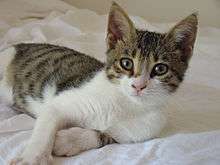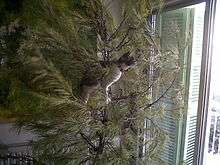Cyprus cat
| Cyprus shorthair cat | |
|---|---|
 A short-haired female Cyprus kitten | |
| Other names | Cypriot cat |
| Origin | Egypt or Palestine |
| Domestic cat (Felis catus) | |
| Cyprus longhair cat | |
|---|---|
 A semi-long-haired adult male Cyprus cat | |
| Other names | Cypriot cat |
| Origin | Egypt or Palestine |
| Domestic cat (Felis catus) | |
The Cyprus cats are grouped into two subspecies namely Aphrodite Giant [1] and Saint Helen Cat. On 1 July 2012, the Aphrodite cat became a fully recognised breed of the World Cat Federation.[2] [3] The most influential period for the Cyprus cat's development occurred in 328 AD when two boatloads of cats were sent to the island from Egypt and Palestine by St Helena. This was done to combat the infestation of snakes on the island following a drought lasting 37 years. The cats were able to breed for twelve hundred years with little outside influence; this has resulted in a breed of cat which is unique, robust, and extremely healthy.
History
According to research conducted by J.-D. Vigne, et al. the oldest example of a domesticated cat may be found in Cyprus. The recorded history of the Cyprus Cat starts some 9500 years ago and was brought into the public domain as a result of the archaeological discovery of domesticated cat remains by a French archaeologist, Prof. Jean Guillain, in 2004. The archaeologists working at the Neolithic site of Shillourokambos, uncovered carefully interred remains of a cat alongside human remains and decorative artifacts. "Examination showed that a small pit or grave had been deliberately dug out, and the body of the cat was placed in it, then rapidly covered." The cat skeleton predates Egyptian depictions of cats by 4,000 years or more.[4]
The Cyprus cat is linked with the Byzantine monastery peculiarly named "St. Nicholas of the Cats" (Greek Άγιος Νικόλαος των Γατών), which was founded in the fourth century AD. It is located near Akrotiri (village). According to Byzantine legend, St. Helen imported hundreds of cats from Egypt or Palestine in the fourth century to control venomous snakes that had infested the monastery. The monastery had two bells, one to call the cats for meals and the other to send to the fields to hunt snakes. The monastery's population of cats once dwindled but has now revived thanks to the resident nuns.[5]
The Nobel Laureate, Giorgos Seferis, wrote of the Cyprus cat in his poem, "The Cats of St. Nicholas" translated by Edmund Keely and Philip Sherrard in 1995.[6]
Characteristics
The Cyprus cat, a close relative of the Cyprus Longhair, is an athletic and energetic variety found throughout the island of Cyprus; from mountainous and cooler regions to the lower, hotter areas near the coasts. As such, this cat has adapted to different climates.
Many Cypriot cats can be found in the cities of Cyprus, including Limassol, Nicosia, Paphos, and Larnaca. In many cases, large populations have become feral.

Aphrodite Giant
In 2008 a WCF all-breeds judge visited Cyprus to judge at a cat show and was introduced to the breeder. He considered that these cats were, indeed, different. He wrote a Standard of Points, and named them Aphrodite Giant cats. The President and Board Members of the WCF advised that the Aphrodite cats should be shown as widely as possible outside Cyprus so that they could become known within the Cat Fancy. Subsequently, a group of interested people in Cyprus decided to form a club, which was named the Cyprus Cats National Breed Association. The CyCNBA applied for Government approval and started functioning in late 2009. CyCNBA applied to affiliate to the World Cat Federation in April 2012.
In addition, it was agreed that a letter be sent to Professor Leslie Lyons of U.C. Davis, California (the leading specialist in cat genetics), asking whether she would agree to DNA test a selection of Cyprus cats to see whether it was possible to genetically define them as a breed. The Professor, who intended shortly to begin a further study of Turkish Van and Turkish Angora cats, agreed to study samples submitted from Cyprus. A total of 248 cats were studied, including a number of random bred Cyprus cats from the Malcolm Cat Sanctuary, for comparison. “All cats were considered in one large analysis. The analysis partitioned the cats based solely on genetic variation, not by any other identification.” (L.Lyons – 2 January 2012) The January 2012 report concluded in its Overall summary that “Cyprus cats are a distinct population within the Mediterranean” and that a “breed from Cyprus could be developed.”
Aphrodites are strong, lively, very affectionate and active cats. They love to play and often develop very close relationships with one particular care giver, rather as dogs do.
References
- ↑ Aphrodite's Giant Longhair - WCF - World Cat Federation
- ↑ The Word Cat Federation recognised it after the Cyprus Cats National Breed Association (CyCNBA) attended the WCF General Assembly in Gelsenkirchen, Germany and applied for recognition of the Aphrodite Giant cat in April 2012.
- ↑ In September 2017 The International Cat Association (TICA) recognized the Aphrodite as a Preliminary New Breed.
- ↑ J.-D. Vigne; J. Guilaine; K. Debue; L. Haye & P. Gérard (April 9, 2004). "Early Taming of the Cat in Cyprus". Science. 304. p. 259.
- ↑ Marc Dubin (2009). The Rough Guide To Cyprus. Rough Guide. pp. 135–136.
- ↑ George Seferis, Collected Poems. Princeton University. 1995.